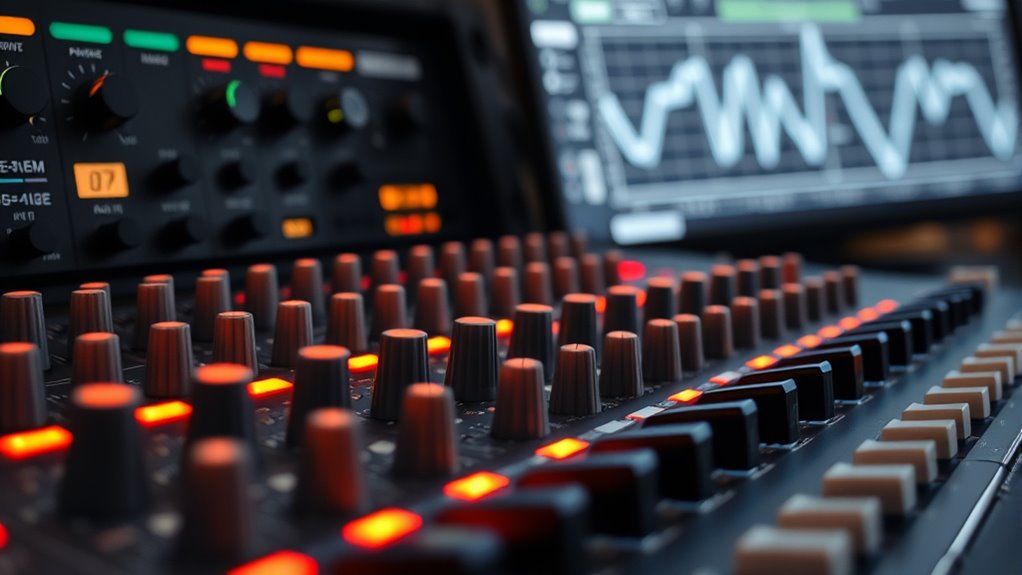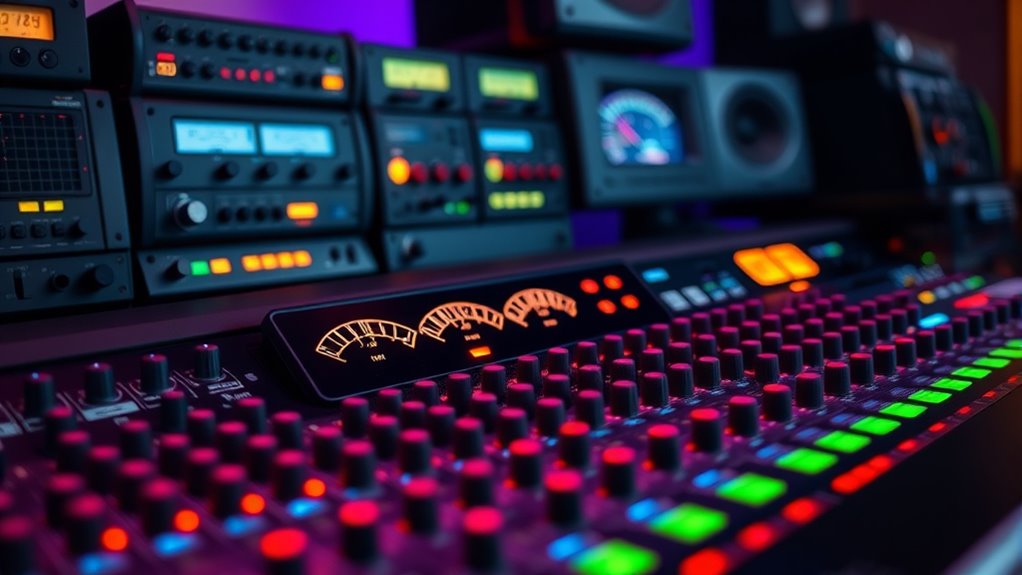Phase misalignment secretly weakens your low end and clouds your mix without obvious signs. When your sound waves are out of sync, they cancel each other out, making bass notes thin or muddy. Proper phase alignment keeps waveforms in sync, boosting clarity and fullness. Small adjustments can make a huge difference. If you want to uncover how to fix these hidden issues and release better low-end power, there’s much more to explore.
Key Takeaways
- Misaligned phase causes cancellation in low frequencies, resulting in thin, muddy, or hollow bass sounds.
- Proper phase alignment restores bass fullness by preventing wave interference and cancellation.
- Use phase correlation meters and visual tools to detect and correct phase issues early.
- Small adjustments, like nudging tracks or re-recording, can significantly improve low-end clarity.
- Consistent monitoring and phase management ensure tight, resonant, and balanced low-frequency performance.
Understanding Phase and Its Role in Sound Waves

Have you ever wondered how multiple sound waves combine to create the sounds we hear? When you play an instrument or sing, your sound waves interact with those from other sources. These waves can align perfectly or be out of sync, affecting how loud or soft certain sounds feel. This interaction is called phase. When waves are in phase, their peaks and troughs align, boosting the sound. When out of phase, they cancel each other out, reducing or even eliminating parts of the sound. Understanding phase helps you grasp why some sounds seem fuller or thinner. It’s an essential concept because it influences how audio signals merge, shaping the overall clarity, volume, and richness of your mix. Proper phase alignment is especially important in home theater setups where multiple speakers need to work together seamlessly. Ensuring correct phase relationships prevents audio from sounding hollow or muffled and is crucial for achieving optimal sound quality. Mastering phase ensures your sound stays tight and balanced.
How Phase Issues Affect Your Low-End Frequencies

When your low-end frequencies aren’t properly aligned, waves can cancel each other out, causing thin or muddy bass sounds. Interference patterns between multiple sources can create uneven bass response that’s hard to control. Phase cancellation effects directly impact the power and clarity of your low frequencies, making proper alignment essential.
Cancellation of Waves
Phase cancellation occurs when two or more sound waves interact in ways that reduce or eliminate certain frequencies, particularly in the low-end. When these waves are out of sync, they can interfere destructively, causing parts of the sound to cancel each other out. This results in a thin, weak bass or gaps in your low-frequency spectrum. You might notice that certain kicks or bass notes seem muffled or disappear altogether when multiple tracks or microphones combine. This is because their waveforms are misaligned, creating points where their amplitudes oppose each other. To fix this, you need to identify and correct phase issues, ensuring that these waves reinforce rather than cancel each other. Proper phase alignment restores fullness and clarity to your low end. Regularly checking vertical storage solutions can help maintain an organized workspace, making it easier to troubleshoot technical issues like phase problems. Additionally, using phase alignment tools can significantly improve the coherence of your low frequencies, preventing phase issues from undermining your mix.
Frequency Interference Patterns
Misaligned waveforms don’t just cancel out sound; they create complex interference patterns that shape your low-end frequencies. When signals aren’t perfectly aligned, they combine in ways that either amplify or diminish certain bass notes. These interference patterns cause fluctuations in volume and tone, making your bass sound uneven or muddy. You might notice that some low frequencies seem weak or overpowering, depending on how the waves interact. Small phase shifts between tracks or microphones can lead to unpredictable peaks and valleys in the sound spectrum. Understanding these interference patterns helps you identify why your low end isn’t sitting right. By analyzing how these waveforms overlap, you gain insight into managing phase relationships and achieving a tighter, more balanced bass response. Additionally, using proper speaker placement and acoustic treatment can help minimize undesirable phase issues in your setup.
Phase Cancellation Effects
Poor phase alignment can cause your low-end frequencies to cancel each other out, leading to a weak or hollow bass response. When signals are out of sync, they interfere destructively, reducing the overall intensity of your bass. This cancellation results in muddy or thin sounds that lack punch. To identify and fix phase cancellation issues, consider these steps:
- Check phase alignment between multiple tracks or microphones to ensure they’re in sync. Proper Mazda Tuning techniques can help in managing sound system phase issues, especially when customizing audio setups. Additionally, understanding audio phase concepts can improve your troubleshooting accuracy. Recognizing how automation impacts sound mixing can also be useful in complex setups.
- Use phase inversion tools to correct signals that are out of phase.
- Utilize visual phase meters or software to spot problematic phase relationships easily.
- Remember that residency requirement laws in various locations can influence when and where you can address these issues if working in a professional studio setting.
Addressing phase cancellation helps restore clarity and power to your low frequencies, making your mix sound fuller and more impactful. Proper phase management transforms a weak bass into a tight, resonant foundation.
Common Sources of Phase Misalignment in Mixing

When working with multiple audio sources, various factors can cause phase issues that affect your mix’s clarity and punch. One common source is microphone placement; placing mics too close or at conflicting angles can cause phase discrepancies between signals. Similarly, using multiple microphones on the same instrument, like a drum kit, can lead to phase cancellation if they aren’t phase-aligned. EQ settings also play a role—boosting or cutting certain frequencies can shift phase relationships, especially with steep filters. Additionally, time delays introduced by effects or digital processing can misalign signals. Even stereo widening effects or panning decisions can create phase issues if not carefully managed. Recognizing these sources helps you identify potential phase problems early and correct them for a tighter, more focused mix. Properly managing phase relationships during mixing is essential for achieving a balanced and professional sound, and understanding how different audio signals interact phase-wise can greatly improve your mixing accuracy. Being aware of supermarket hours and their variations can also help optimize your shopping trips when managing your schedule around busy days. To further minimize phase issues, employing phase alignment tools can assist in correcting misalignments quickly and effectively.
Detecting Phase Problems in Your Tracks

Detecting phase problems early is essential for achieving a clear and punchy mix. When phase issues occur, they can cause thinness, lack of depth, or muddiness. To identify these problems:
- Listen critically: Solo tracks and compare them to the full mix. If something sounds hollow or out of sync, phase may be the culprit.
- Use phase correlation meters: These tools show how aligned your tracks are. A reading close to +1 indicates good alignment, while lower or negative values suggest phase issues.
- Invert the phase of individual tracks: Temporarily flip the phase on a track and see if the sound becomes fuller or more defined. If it improves, phase cancellation might be affecting your mix.
Techniques to Correct Phase Alignment

To correct phase alignment issues, you can start by using phase inversion tools available in most digital audio workstations. Solo each track and toggle the phase inversion button to listen for improved clarity and punch. Adjust timing by nudging tracks slightly forward or backward to align waveforms precisely. Sometimes, you’ll need to mute or re-record certain elements to prevent cancellation. Remember, small adjustments can make a big difference. Additionally, understanding sound healing science can also inspire creative techniques for achieving desired audio effects. Incorporating biodiversity principles into your mixing process—such as balancing frequencies to create a more natural soundscape—can further enhance the clarity and warmth of your audio. Paying attention to the phase relationship between elements can help prevent issues like comb filtering and ensure a fuller sound.
Tools and Plugins for Managing Phase Issues

Fortunately, a variety of tools and plugins are available to help you manage phase issues efficiently. These tools make it easier to identify and correct phase problems quickly, saving you time and preserving your low end. Here are three essential options:
- Phase Rotator Plugins – Allow you to adjust the phase of individual tracks without affecting their pitch or timing, helping align signals perfectly.
- Spectral Analyzers with Phase Scope – Visualize phase relationships across frequencies, making it easier to pinpoint problematic areas.
- Stereo Wideners with Phase Control – Enable you to enhance stereo imaging while maintaining phase coherence, preventing phase cancellation.
Using these tools, you can troubleshoot phase problems effectively, ensuring a tight, balanced mix with a strong low end.
Best Practices for Maintaining Phase Coherence in Your Mixes

Maintaining phase coherence throughout your mix is essential for achieving clarity and punch. To do this, always start by checking your tracks with phase-alignment tools or visual meters to spot issues early. When layering multiple microphones or recordings, ensure they’re time-aligned before blending. Use high-quality plugins to correct phase problems rather than relying solely on EQ cuts, which can cause unintended phase shifts. Keep your monitors at a consistent volume and position to accurately hear phase relationships. Regularly listen in mono to identify phase cancellation issues that might go unnoticed in stereo. Be cautious with parallel processing—double-check that added effects or layers don’t introduce phase conflicts. Staying mindful of these practices helps you maintain tight, coherent mixes with powerful low end and clear overall sound.
Frequently Asked Questions
Can Phase Issues Be Audible in Mono Versus Stereo Playback?
You might notice phase issues more clearly in mono playback because all sounds are combined into one channel, making cancellations more obvious. In stereo, some phase problems can be masked or less noticeable due to different signals in each channel. If your low end sounds weak or hollow in mono, it’s a good sign that phase issues are affecting your mix. Always check in mono to catch these hidden problems.
How Does Room Acoustics Influence Phase Alignment in Recordings?
Room acoustics greatly influence phase alignment because reflections and standing waves can cause signals to arrive out of sync. When sound bounces off walls, it creates delays that affect the timing and phase relationships of your recordings. This can result in muddiness or loss of clarity, especially in the low end. To improve phase coherence, you should treat your room with bass traps and diffusers, ensuring a more accurate and balanced sound.
Are There Specific Genres More Prone to Phase Problems?
Certain genres, like electronic dance music, rock, and hip-hop, are more prone to phase problems because they often rely heavily on multiple microphones, layered sounds, and complex mixing techniques. When you work within these styles, you might notice more issues with low-end clarity and stereo imaging. To avoid this, pay close attention during recording and mixing, ensuring proper phase alignment to preserve the punch and depth of your tracks.
How Often Should I Check for Phase Issues During Mixing?
Did you know that up to 85% of mixes can suffer from phase issues? You should check for phase problems every time you add or change a track during mixing. Regularly listen in mono, compare waveforms, and use phase correlation meters. Doing this maintains your low end tight and clear, preventing phase cancellation from ruining your mix. Consistent checks ensure your sound remains punchy and well-defined.
Can Phase Problems Cause Damage to Speakers or Equipment?
Phase problems typically won’t damage your speakers or equipment directly, but they can cause significant sound quality issues. When your audio is out of phase, it leads to cancelation and weakens the low end, making your mix sound thin and muddy. Over time, pushing your gear to compensate for these issues may strain components, but the primary concern is compromised sound clarity, not physical damage. Always check and correct phase for the best sound.
Conclusion
Imagine your mix as a vibrant city skyline at dusk, where every building’s alignment creates a seamless silhouette. When phase issues creep in, it’s like crooked shadows that obscure your low end, dulling its punch and depth. By understanding and correcting these invisible misalignments, you bring clarity and power back to your soundscape. Stay vigilant, keep your phase tight, and watch your bass and kicks stand tall and commanding in the mix.










